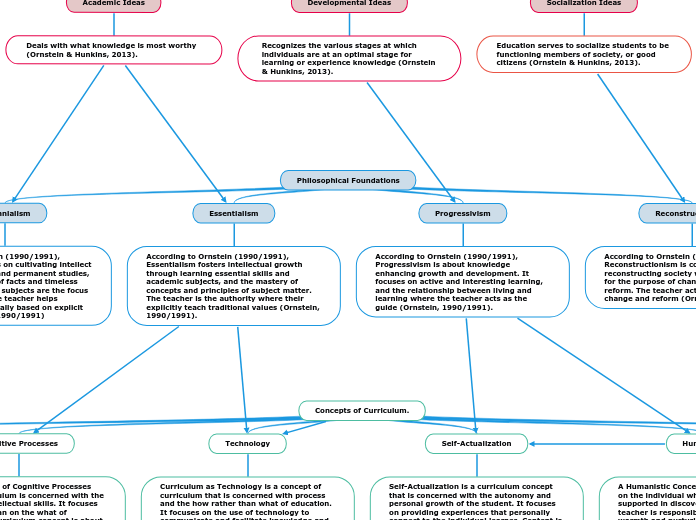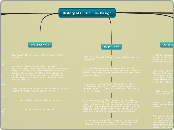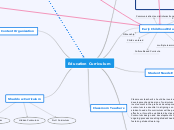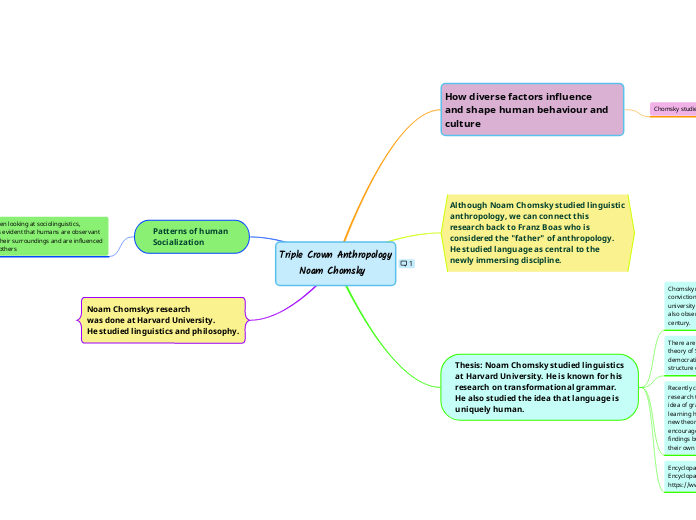Summary
Conceptions of curriculum, philosophies, and curricular design are all intertwined. As we implemented the concepts and viewed the map it was evident to us that philosophy and curricular concepts are essential when thinking about curricular design. It gives you purpose in planning. As an educator when you look at this visual it is important to see that all components play an important role with each other. Having a philosophy lens aligns with how you will implement and present the curriculum to students. Which trickles down to curricular concepts. Educational purpose, philosophies and concepts of curricular allows you to give you an insight to why and how the curriculum was designed. This visual is designed to help align one’s practice when choosing a path to promote the specific kind of learning that one wants students to make. Each path aligns the philosophical framework, curriculum concepts, and curriculum designs to the planning, instruction and assessment. In our practice as teachers, we often set intentions for the kinds of learning we want to take place. However, when we design these learning opportunities, they are not always truly aligned with designs, frameworks, instruction, and/or assessment that best support that kind of learning. This visual therefore helps an educator align the learning intention for students from philosophy, to curricular concepts and design, to assessment, instruction, and planning for the purpose of student learning. Our map shows a connection of how assessment plays a crucial role in our conceptions, philosophies, and designs listed above. You can see how assessment drives instruction and planning. Regardless of which approach an educator chooses, it is important that all aspects align, from philosophical framework, concepts of curriculum, design, to planning, instruction, and assessment to create meaningful learning for students
Revised Summary
Conceptions of curriculum, philosophies, and curricular design are all intertwined. This is a visualization demonstrating the relationships of the different conceptions of curriculum to the different philosophical foundations, then to the different curricular designs, and finally to assessment, instruction, and planning. As we implemented the concepts and viewed the map it was evident to us that philosophy and curricular concepts are essential when thinking about curricular design. It gives you purpose in planning. As an educator when you look at this visual it is important to see that all components play an important role with each other. Having a philosophy lens aligns with how you will implement and present the curriculum to students, which then trickles down to curricular concepts. Having an understanding of educational purpose, philosophies and concepts of curriculum allows you to develop an aligned practice and gives you insight to why and how the curriculum was designed. This visual is designed to help align one’s practice when choosing a path to promote the specific kind of learning that one wants students to make. Each path aligns the philosophical framework, curriculum concepts, and curriculum designs to the planning, instruction and assessment.
In our practice as teachers, we often set intentions for the kinds of learning we want to take place. However, when we design these learning opportunities, they are not always truly aligned with designs, frameworks, instruction, and/or assessment that best support that kind of learning. This visual therefore helps an educator align their learning intentions for students from philosophy, to curricular concepts and design, to assessment, instruction, and planning for the purpose of student learning. Our map shows a connection of how assessment plays a crucial role in our conceptions, philosophies, and designs listed above. You can see how assessment drives instruction and planning. Regardless of which approach an educator chooses, it is important that all aspects align, from philosophical framework, concepts of curriculum, design, to planning, instruction, and assessment to create meaningful learning for students.
“Kids prosper best with a broad curriculum that celebrates their various talents” Sir Robertson (Learner Mindset, 2021). Our map gives a clear example of how implementing quality assessment tools in classrooms can promote authentic learning that aligns with curriculum design, curriculum concepts, and a philosophical framework for education.
References:
Al Mousa, N. (2013). An examination of cad use in two interior design programs from the perspectives of curriculum and instructors, pp. 21-37
Eisner, E., & Vallance, E. (Eds.). (1974). Five conceptions of the curriculum: Their roots and implications for curriculum planning. In E. Eisner & E. Vallance (Eds.), Conflicting conceptions of curriculum (pp. 1-18). Berkeley, CA: McCutchan Publishing.
Learners Mindset. (2021). Aligning Outcomes, Activities & Assessments: Learners Mindset Fundamentals. YouTube. https://youtu.be/YsmbuD00Vfg
Ornstein, A. C. (1990/1991). Philosophy as a basis for curriculum decisions. The High School Journal, 74, 102-109.
Ornstein, A. C., & Hunkins, F. P. (2013). Curriculum: Foundations, principles, and issues (6th ed.). Boston, MA: Pearson.
McMillan, J. H. (2014). Classroom assessment: Principles and practice for effective standards based instruction (6th ed., pp. 1-20, 57-64,74-88). Boston, MA: Pearson.
McNeil, J. D. (2009). Contemporary curriculum in thought and action (7th ed.). Hoboken, NJ: John Wiley.
Sowell, E. J. (2005). Curriculum: An integrative introduction (3rd ed., pp. 52-54, 55-61, 81-85,103-106). Upper Saddle River, NJ: Pearson.
Shepard, L. A. (2021). Ambitious Teaching and Equitable Assessment. https://www.aft.org/ae/fall2021/shepard
Valenzuela, J. (2022, February 18). A Simple Tool for Aligning Instruction and Assessment. https://www.edutopia.org/article/simple-tool-aligning-instruction-and-assessment/
Curriculum Design
Other
Other designs yield classification by source of content. They are technology curriculum, school-to-work curriculum, and core curriculum. This curriculum offers students distinctive opportunities to study subject matter (Sowell, 2005).
For these other designs, consider how assessment informs instruction and planning through a backward design to align your practice.
- Performance based assessment
- Teacher observations
- Oral questioning - Selected response - Brief constructed response
- Experience based
- Differences in interests, aptitudes, and capacities - Directed through sequenced set of activities
- Work based learning
- Classification by source of content
- Sequenced set of activities
- Subject matter
Society-Culture Based
Society-Culture curriculum is established on the needs of society and culture are rooted in the study of life in society, major activities of social life, or social problems. The emphasis is on problem-solving processes and social-human relations skills rather than on acquiring content (Sowell, 2005).
- Performance based assessment
- Teacher observations
- Oral questioning
- Problem-solving processes and social-human relations skill
- Experiential learning activities - Culturally responsive teaching strategies used - Community members included to transmit cultural knowledge and values
- The study of life in society, major activities of social life, or social problems
- Values experience approach
- Investigates problems in the community
- Collaboration between community members, educators, stakeholders, Elders - Cultural integration
Problem-Centered
Problem-Centered designs pivot on real-life problems of individuals and society. Its intent is to reinforce cultural traditions and address unmet needs of the community and society. The various types of problem-centered design differ in the degrees to which they emphasize social needs, as opposed to individua needs. The specific designs are life-situations and reconstructionist (Ornstein & Hunkins, 2013).
- Teacher observation- formal and informal
- Student self assessment- self report inventories, self-evaluation
- Oral questioning- interviews, conferences
- Constructed response- project, exhibition, journal, debate, enactment
- Feedback- qualitative ( written comments or a discussion)
- Formative and summative assessments
- Problem solving procedure
- Critical analysis
- Experiences approach
- Vertical and horizontal dimensions
- Scope, sequence, continuity, integration, articulation and balance design dimensions
- Teachers is scaffolding learning
- Inquiry learning
- Real life problems of individuals and society are identified
- Address societal issues
- Address students’ needs, concerns and abilities
- Process and content are integrated
- Students past and present experiences are fostered
- Teacher is a guide/facilitator - Interdisciplinary collaboration
Learner-Centered
Learner-Centered designs are mostly used at the elementary level because the teachers emphasize the whole child. Whereas, high school is more subject centered. It fosters two big ideas: socialization and Rousseau's developmental ideas. The specific designs are child-centered, experience, romantic, and humanistic (Ornstein & Hunkins, 2013).
- Formative assessment for learning
- Ongoing assessment
- Teacher observation- informal and formal
- Student-self assessment
- affect/dispositions- student self reports and questionnaires
- Direct oral questioning
- Feedback driven
- Classroom opportunities to explore physical, social, emotional, and logical knowledge
- Promote self-actualization
- Self-directed learning
- Creativity encouraged
- Integrate subject matter from various fields
- Teachers and students plan together; child driven - Responsive to student interests in the moment
- Based on children’s needs and interests
- Teacher is a guide; scaffolds learning
- Process oriented
- Differentiation of learning
- Inquiry learning
- Students help select and organize the purposes of learning - Responsive to student needs and interests.
- Grounded in curricular big ideas that act as the framework for how to engage students in understanding and moving them forward in their learning
Subject-Centered
Subject-Centered designs are the most popular and widely used. Knowledge and content are well accepted as integral parts of the curriculum. This design is heavily based on Plato's academic idea. It entails many design classifications such as subject, discipline, broad-fields, correlation and process (Ornstein & Hunkins, 2013).
Assessment
- Observation
- Summative assessment of learning
- Selected response (multiple choice, matching)
- Knowledge and simple understanding through selected response, essay, question
- Objective scoring
Instruction
- Textbooks used
- Teachers are the subject expert and transmit knowledge through lecturing and presenting
- Direct instruction
- Recitation
- Large group discussions
- Skills and competencies based
- Discussion proceeds from simple to complex ideas; logic
- Mastery learning
Planning
- Content and subject driven
- Teacher is subject specialist - Clearly defined learning objectives and goals
- Knowledge based
- Problem solving
- Transmitting facts/skills
- Units of learning with scope and sequence - Thematic Instruction- the content to be taught is selected and organized before instruction
Concepts of Curriculum.
Social Reconstruction
Social Reconstruction is a concept of curriculum that stresses societal needs over individual needs. It places a high emphasis on the role of education and curriculum content within the larger social context. Schools are required to recognize their role as the bridge between what is and might be, with the real and ideal society. Curriculum is the tool to enable the learner to survive and function in an unstable and changing world. The curriculum uses societal issues of the day, social values are tested, and students learn to deal with social issues. (Al Mousa, 2013, and Eisner & Vallance, 1974)
Humanistic
A Humanistic Concept of Curriculum focuses on the individual where the learner is supported in discovering who they are. The teacher is responsible for both providing warmth and nurturing emotions, as well as being a resource center for students. The process of learning is evaluated, rather than the end product. (Al Mousa, 2013 and McNeil, 2009)
Self-Actualization
Self-Actualization is a curriculum concept that is concerned with the autonomy and personal growth of the student. It focuses on providing experiences that personally connect to the individual learner. Content is important as it must relate to the learner and sees schooling as fully entering a learner's life through the curriculum. Learners are encouraged to discover and make sense of learning on their own. (Al Mousa, 2013, and Eisner & Vallance, 1974)
Technology
Curriculum as Technology is a concept of curriculum that is concerned with process and the how rather than what of education. It focuses on the use of technology to communicate and facilitate knowledge and learning. (Al Mousa, 2013, and Eisner & Vallance, 1974)
Cognitive Processes
The Development of Cognitive Processes concept of curriculum is concerned with the refinement of intellectual skills. It focuses on how rather than on the what of education. This curriculum concept is about developing the cognitive skills that can be applies to learning in any area. It aims at providing students with intellectual autonomy that will enable them to make their own selections and interpretations beyond the school walls. (Al Mousa, 2013, and Eisner & Vallance, 1974)
Academic Rationalism
Academic Rationalism as a concept of curriculum is concerned with students acquiring the tools and knowledge to participate in Western traditional culture. Classic disciplines are to be taught in the curriculum. A child's intellect is cultivated by providing opportunities to acquire the most powerful knowledge. (Al Mousa, 2013, and Eisner & Vallance, 1974)
Educational Purposes
Socialization Ideas
Education serves to socialize students to be functioning members of society, or good citizens (Ornstein & Hunkins, 2013).
Developmental Ideas
Recognizes the various stages at which individuals are at an optimal stage for learning or experience knowledge (Ornstein & Hunkins, 2013).
Academic Ideas
Deals with what knowledge is most worthy (Ornstein & Hunkins, 2013).
Philosophical Foundations
Reconstructionism
According to Ornstein (1990/1991), Reconstructionism is concerned with reconstructing society where education is for the purpose of change and social reform. The teacher acts as an agent of change and reform (Ornstein, 1990/1991).
Progressivism
According to Ornstein (1990/1991), Progressivism is about knowledge enhancing growth and development. It focuses on active and interesting learning, and the relationship between living and learning where the teacher acts as the guide (Ornstein, 1990/1991).
Essentialism
According to Ornstein (1990/1991), Essentialism fosters intellectual growth through learning essential skills and academic subjects, and the mastery of concepts and principles of subject matter. The teacher is the authority where their explicitly teach traditional values (Ornstein, 1990/1991).
Perennialism
According to Ornstein (1990/1991), Perennialism focuses on cultivating intellect by focusing on past and permanent studies, and on the mastery of facts and timeless knowledge. Classical subjects are the focus of curriculum and the teacher helps students think rationally based on explicit teaching (Ornstein, 1990/1991)









